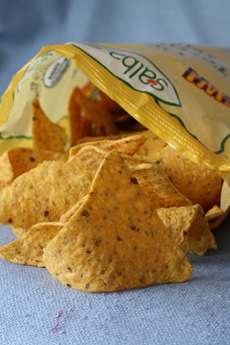

Salba corn chips with chia seeds. Photo by Hannah Kaminsky | THE NIBBLE.
|
KAREN HOCHMAN is Editorial Director of THE NIBBLE.
|
|
May 2007
Last Updated January 2014
|
 |
Best Tortilla Chips
In Search Of The Best Gourmet Corn Chips
Jump to the chart
CAPSULE REPORT: In our small-scale search for corn tortilla chips—we tried only a dozen brands—the best were made, probably not surprisingly, under the label of two different Mexican restaurants. The mass-marketed brands, compared to the specialty brands, were dreadful: Salty and dusty with no corn flavor, we couldn’t get them off the table fast enough. The price differential between mass and class is modest: If you’re chipping away at perfection, go for the specialty brands. By the way, corn chips are gluten-free. This is Page 1 of a two-page article. Click on the black links below to visit Page 2.
Overview
Who would have thought it would be so difficult to find a good tortilla chip? A tortilla chip is made simply by frying wedges of corn tortillas (sometimes they are referred to as corn chips).
Perhaps our perspective is warped: We mostly eat chips at better Mexican restaurants, where they are either made in-house or purchased fresh from specialist suppliers, and served unsalted. They are so good—and the homemade salsa fresca so much more refreshing than the very good jarred varieties we eat at home—that we’d be happy just to have two baskets of chips and salsa for dinner.
Our foray into packaged chips was a different experience entirely. Half the brands tasted dusty—the taste on the palate was dry and powdery. Half were overly salty and several had both flaws. Some—especially supermarket brands—were so dusty and salty as to be unenjoyable, the excessive salt burning our lips (a new and unpleasant experience) and making us want to wash away the salt and the dusty taste with lots and lots of beer. But, this being the middle of the work day, we soldiered on.
We read the ingredients on each bag. It’s interesting how such a simple product—most of the better chips used stone ground corn and were fried in canola and/or sunflower oil, then seasoned with salt—taste so different. Lime juice added to some brands, presumably as a flavor enhancer, was not discernable, and the brands with the added lime juice were not the “winners.”
For the purpose of this review, we tasted only plain chips—not flavored varieties (Chili & Lime or Guacamole flavor, for example; we did include a brand that mixes corn with whole wheat and rice, or beans and another that adds chia seeds for omega-3s). But, when making simple products—burgers from ground round, linguine from durum wheat or tortilla chips from ground corn—seemingly similar base ingredients do vary widely in quality, as do production techniques, and result in remarkably different end products.
The Difference Between Corn Chips & Tortilla Chips
Corn chips and tortilla chips are both fried snacks. Some people use the term interchangeably. But there is a difference:
- Corn chips, like Fritos, are not made from slices of tortillas. Instead, they are made from corn meal which has been processed into a particular shape.
- The corn in a tortilla and that in corn chips is different. The corn in a tortilla chip has undergone a process known as nixtamalization, which involves soaking the raw corn in an alkaline solution, then hulling it. This was done by ancient Americans to make it easier to grind the corn. Modern scientists note that the process increases the nutritional value; the flavor and aroma are also enhanced.
Continue To Page 2: Chip Tasting Notes
Go To The Article Index Above
|




